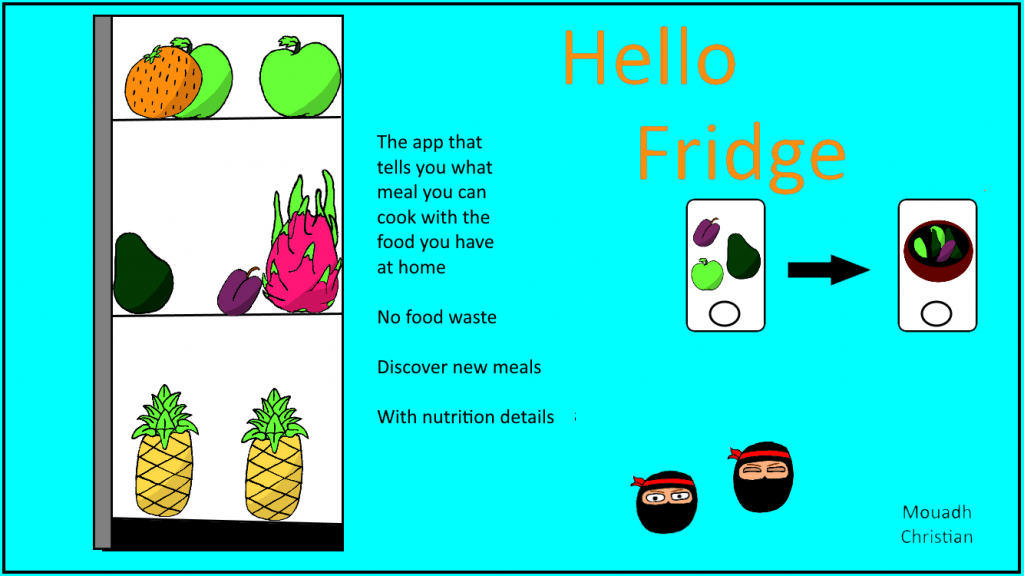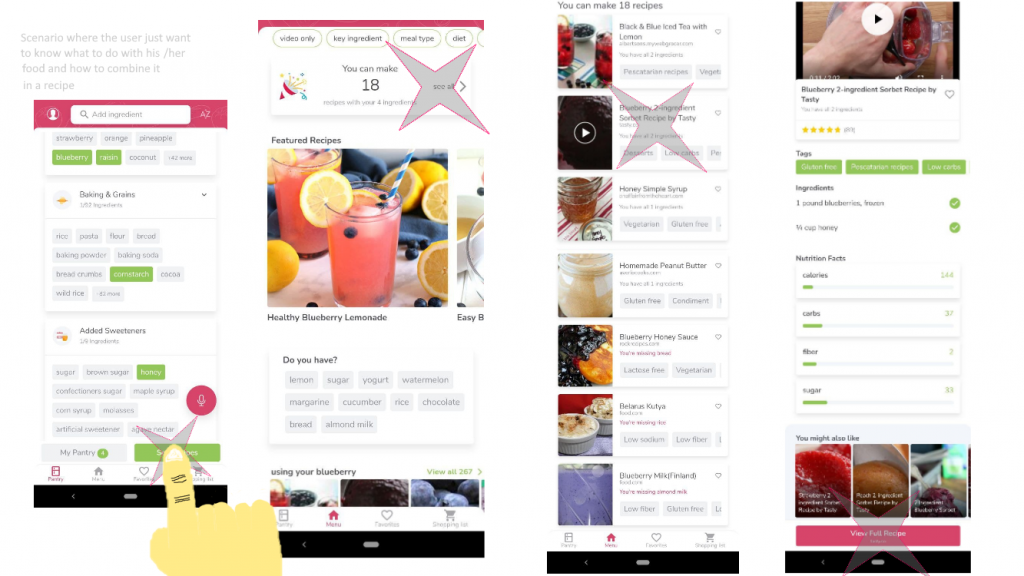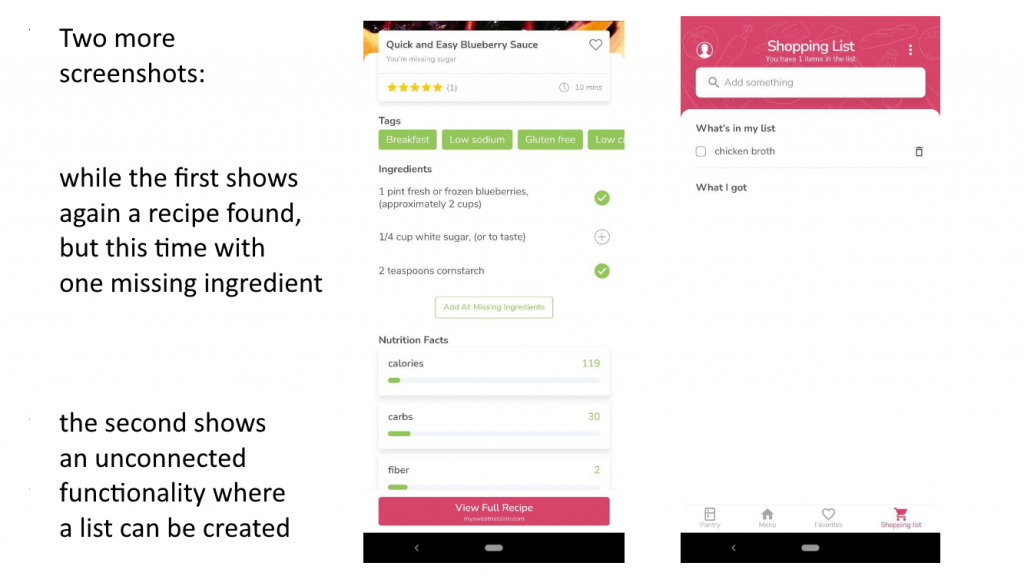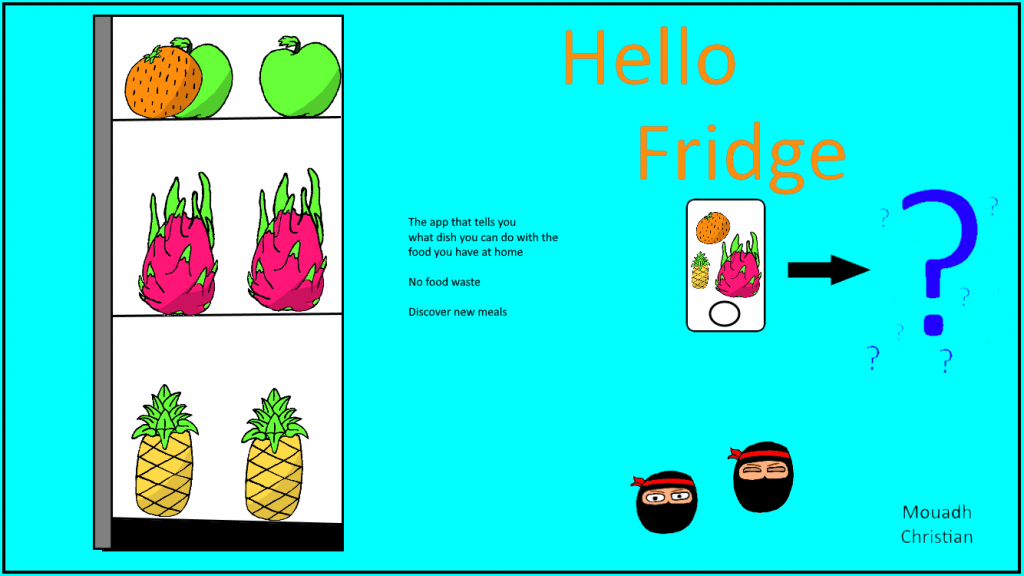
For our in-depth interview, we created the following questions while the goal was to become aware of the meal ideation process
1- How do you plan your meals?
2- When do you plan your meals?
3- What do you think about fast food?
4- Do you cook regularly?
Yes => Where are your recipes coming from?
No => Name the reasons
5- What do you think about a meal planner?
We are developing an app which is recommending you recipes for food that you do not know how to use. It is new because your only input are the ingredients that you want to use for it; and allergies.
6- On a scale from 0 to 10, how willing are you to download an app which helps you with the cooking?
7- If you had such a mobile application, would you use it for your daily eating habits or occasionally?
8- Which ingredients generally remains when you must go for groceries again?
9- What colour intuitively represents food in your opinion?
10- What form of recipe is appealing to you the most?
A- Text
B- Pictures
C- Video
11- If you think about your social circle, to how many acquaintances would you recommend such an app?
12- How would you like such an application to be called?
In our project, it’s best to analyze existing software
1.Document your method and the type of data you are gathering.
During our research, we become inspired by a good working project that we discovered. Our analysis is done with the following steps: 1. Try out the use case written in the previous blog post in the app 2. Protocol during the process all thoughts and become aware of other (potentially for us interesting) use cases 3. Describe the other use cases.
2.Store your collected data.
Supercook was created by Assaf Rozenblatt an it`s an responsive website, Android and iOS App.
„Supercook wants to make life easier for everyone who cooks at home! Our mission is to enable smarter, quicker decisions about what recipes to make and what ingredients to use using advanced technology and all the recipe content on the web. Based in New York, Supercook has a distinct focus on solving the practical problems of modern home cooks: how to waste less food, how to use up perishable or seasonal ingredients and how to keep track of everything in the kitchen“ supercook.com can be easily found with a search engine, just by typing in the word supercook. You will find it on the the top. Similar in the Appstores.
You can see a tutorial screen with the information „Speak to add ingredients Adding ingredients is easy Open your fridge, tap the mic icon, say what you have“ and also „Every ingredient you add unlocks more recipes“, „vegan lasagna without tomato“ and „Search over 1 million recipes“. You can click on „Skip“ or „Get Started“ while both buttons bring you to the same start screen.
On this screen, you can see pretty clearly that it`s time to add ingredients here. You have 3 possibilities to do that. At the top of the screen, you can write in a search bar, after writing the first character you will see the available ingredients. The second option is in the middle of the site and it is a list of ingredients (sorted in meat, vegetables etc.) while each is clickable because they are buttons. The third one is to use natural language processing. At the centre of the screen is always a microphone, which is also a button. Additional to the important button „See Recipes“ which we will click now, we can see other buttons too which will be explained at the end of this analysis.

The relevant/ingredient-dependent recipes are „hidden“ behind one more button. Following it you will see the wished list of recipes for the ingredients chosen, while the same as before each is at the same time a button. Next to the recipes which can be done with the selected ingredients, we can see underneath some others which require 1 more ingredient. Next to this list, you can see filter like „video only“ or „meal type“ and you can also select more ingredients. With a click on a recipe, it`s clear that the categorization is done with tags because we can see here the tags. You can also see here a rating, the cooking time needed, the necessary amount or weight of the ingredients and nutrition facts. With another click, we will be forwarded to one of a few websites because Supercook does not host the full recipes. You can see here links to similar recipes under „You might also like“ too. If you step back to where we found the „hidden“ button we can also see the more ingredients selection and the filter. Additional: Some recipes are shown in a big horizontal slider with the headline „Featured Recipes“ or in many (>20) smaller slider with categories like „low carbs“, „gluten free“ or „cookies“; always with a picture.
Besides the „See Recipes“ button you can see a menu with the name „My Pantry“ where you can deselect your ingredients, a shoppting list which allows to save ingredients in a seperate list and an acctount mode. „If you sign up for an account, your ingredients, and dietary restrictions, will be saved on Supercooks servers. This means you can sign into your account from any device and everything will be synced up. Having an account also allows you to “favorite” recipes you like so you can easily find them later.“

Who did what?
Christian was writing and Mouadh was leading during the gathering
What did we learn?
To come closer to our goal this week was very helpful because we discovered a working product and it`s flow producing. The interview made us aware of the community of people who want to count calories and we will focus on that niche
What went well?
If we can continue like this week it`s very likely that our product will be great.
What do we want to improve?
All writing was good this week but we had problems with the data formating.

